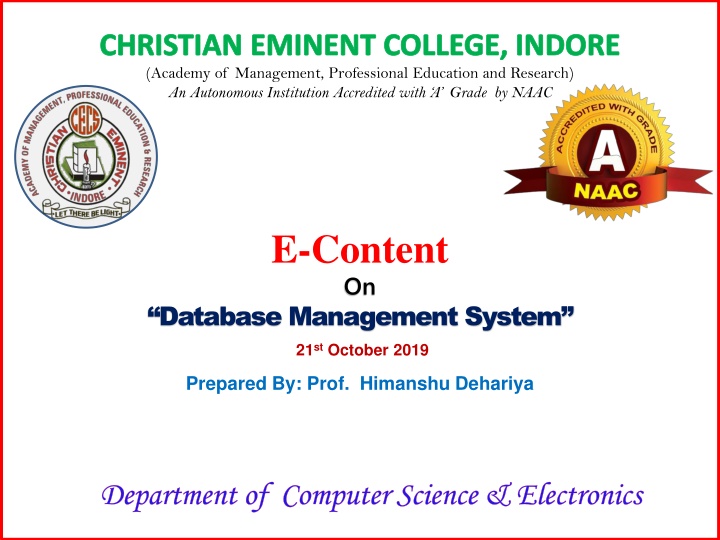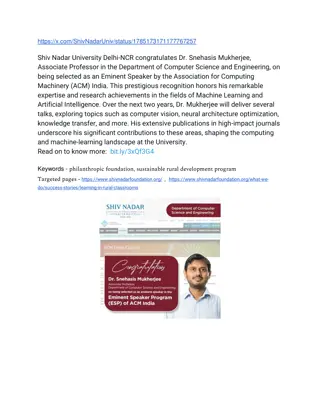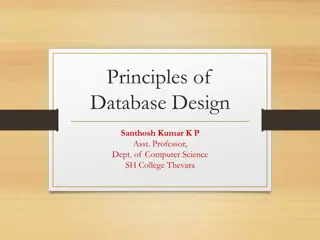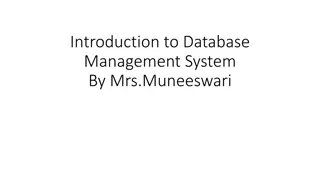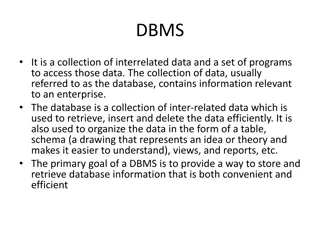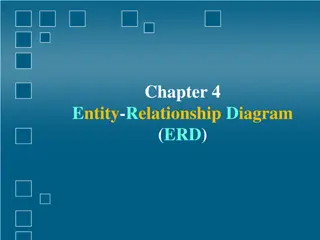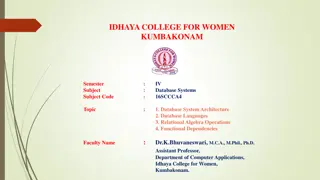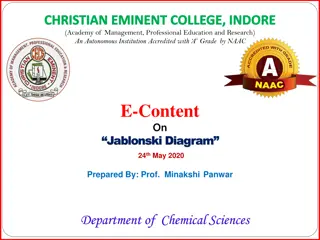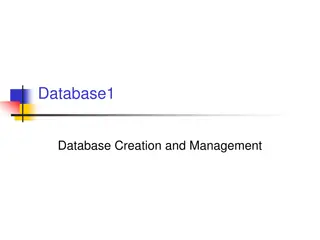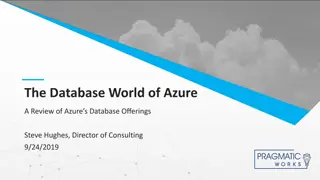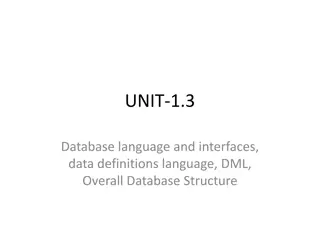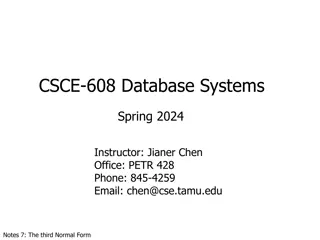Database Management System Overview at Christian Eminent College
This content provides an in-depth look into database management systems, covering topics such as what a database is, its purpose, drawbacks of using file systems, and levels of abstraction. It explores the importance of data independence, efficient access, and security in managing databases. The information is sourced from a reputable institution's e-content on Database Management System.
Download Presentation

Please find below an Image/Link to download the presentation.
The content on the website is provided AS IS for your information and personal use only. It may not be sold, licensed, or shared on other websites without obtaining consent from the author.If you encounter any issues during the download, it is possible that the publisher has removed the file from their server.
You are allowed to download the files provided on this website for personal or commercial use, subject to the condition that they are used lawfully. All files are the property of their respective owners.
The content on the website is provided AS IS for your information and personal use only. It may not be sold, licensed, or shared on other websites without obtaining consent from the author.
E N D
Presentation Transcript
CHRISTIAN EMINENT COLLEGE, INDORE (Academy of Management, Professional Education and Research) An Autonomous Institution Accredited with A Grade by NAAC E-Content On Database Management System 21st October 2019 Prepared By: Prof. Himanshu Dehariya Department of Computer Science & Electronics
What is Database ? A Database is consist of data,relationships,constraints & schema . A collection of data designed to be used by different people is called database . A common and controlled approach for adding, removing or modifying data . A method in which data are stored in such a fashion that they are independent of the programs of people, using data .
Why Database ? Data independence and efficient access. Reduced application development time. Data integrity and security. Uniform data administration. Concurrent access Crash recovery
Database Management System (DBMS) Set of programs to access the data DBMS contains information about a particular enterprise DBMS provides an environment that is both convenient and efficient to use. Database Applications: Banking: all transactions Airlines: reservations, schedules Universities: registration, grades Sales: customers, products, purchases Manufacturing: production, inventory, orders.
Purpose of Database Drawbacks of using file systems to store data: Data redundancy and inconsistency Multiple file formats, duplication of information in different files Difficulty in accessing data Need to write a new program to carry out each new task Data isolation multiple files and formats Integrity problems Integrity constraints (e.g. account balance > 0) become part of program code Hard to add new constraints or change existing ones Concurrent access by multiple users Concurrent accessed needed for performance Uncontrolled concurrent accesses can lead to inconsistencies E.g. two people reading a balance and updating it at the same time Atomicity of updates Failures may leave database in an inconsistent state with partial updates carried out E.g. transfer of funds from one account to another should either complete or not happen at all Security problems Database systems offer solutions to all the above problems
Levels of Abstraction Physical level: describes how a record (e.g., customer) is stored. View 1 View 2 View 3 Logical level: describes data stored in database, and the relationships among the data. Conceptual Schema Physical Schema View level: application programs hide details of data types. Views can also hide information (e.g., salary) for security purposes.
Example:Unversity Database Conceptual schema: Students (sid: string, name: string, login: string, age: integer, gpa:real) Courses (cid: string, cname:string, credits:integer) Enrolled(sid:string, cid:string, grade:string) Physical schema: Relations stored as unordered files. Index on first column of Students. External Schema (View): Course_info (cid:string,enrollment:integer)
Data Models A collection of tools for describing data data relationships data semantics data constraints Example: Entity-Relationship model Relational model
Entity Relationship Diagram E-R model of real world Entities (objects) E.g. customers, accounts, bank branch Relationships between entities E.g. Account A-101 is held by customer Johnson Relationship set depositor associates customers with accounts
Relational Model Example of tabular data in relational model Attributes customer- street customer- city account- number customer- name Customer- id 192-83-7465 Johnson Alma A-101 Palo Alto Smith 019-28-3746 North A-215 Rye Johnson 192-83-7465 Alma A-201 Palo Alto Jones 321-12-3123 Main A-217 Harrison Smith 019-28-3746 North A-201 Rye
Structure Query Language (SQL) SQL is a english like language which is used to retrieve data from the tables.It comprise of three clause, the execution order of these clause is- From - Bring related table in memory. Where - Check specified conditions. Select - Choose the required record. Ex. select ename from emp; select ename, sal from emp; select * from emp;
Types of SQL Statements SQL provides some statements that are used to create various database objects and also provide facility to make an operation to add,remove or modify record in these created objects. DML (Data Manipulation Language)- These statements are used to manipulate data in an database objects like adding a record, deleting a record, modifying an existing record etc. Ex.- Insert, Update, Delete, Select.
DDL (Data Definition Language) These statements are used to make changes in the definition of an database objects like creating an database object,chnging the size of column, adding a new column etc. Ex.- Create, Alter, Drop. DCL (Data Control Language) These statements are used to provide some security aspects to different user like access permissions. Ex.- Grant, Revoke.
TCL (Transaction Control Language) These statements are used to provide some control over the database transaction. Ex.- Commit, Rollback, BeginTRAN.
How to deal with Tables To create Table Create table student ( rno number(5),name varchar2(12), fee number(5) ); To add a record in Table Insert into student values(1, abc ,2000); To modify a record in Table Update student set name= xyz , fee=3000 where rno=1; To delete a table Drop table syudent;
Database Constraints Primary Key Constraint -To uniquely identify a record. Foreign Key Constraint -To establish relationship between the tables. Unique Key Constraint -To uniquely identify a record Self Key constraint - When we make primary & foreign key in the same table. Composite Primary - Key constraint-When two columns joined together to make a primary key. Not null constraint - Columns doesn't allow null value Check constraint - Columns store value if the condition is true.
What is a Transaction A transaction is a collection of operations that performs a single logical function in a database application Transaction-management component ensures that the database remains in a consistent (correct) state despite system failures (e.g., power failures and operating system crashes) and transaction failures. Concurrency-control manager controls the interaction among the concurrent transactions, to ensure the consistency of the database.
Storage Management Storage manager is a program module that provides the interface between the low-level data stored in the database and the application programs and queries submitted to the system. The storage manager is responsible to the following tasks: interaction with the file manager efficient storing, retrieving and updating of data
Database Administrator (DBA) Coordinates all the activities of the database system; the database administrator has a good understanding of the enterprise s information resources and needs. Database administrator's duties include: Schema definition Storage structure and access method definition Schema and physical organization modification Granting user authority to access the database Specifying integrity constraints Monitoring performance and responding tochanges in requirements
Ingres Corporation Ingres Corporation is a leading provider of open source information management services to the enterprise. The Ingres Database offers high-volume transaction processing, high availability, multi-platform support, and security for mission- critical application deployments. It offer our database software as part of integrated software appliances, enabling customers to rapidly and cost-effectively deploy, manage, and maintain open source solutions throughout the enterprise. As an open source company, Ingres has an active community of developers that continually test our code, influence our product roadmap by submitting specific feature requests, and contribute code for inclusion in our software. When integrating their applications with our database, developers increase their productivity given their direct access to our source code.
Ingres Products Ingres Database: Open Source Database= Ingres Database is the open source database management system that can reduce IT costs and time to value while providing the strength and features expected from an enterprise database. Ingres Icebreaker: Integrated Database System=Ingres Icebreaker is the first enterprise-class database with a fully integrated operating system. Ingres Icebreaker includes only the components of the operating system necessary to allow Ingres Database to run on server hardware, eliminating the need for a general-purpose operating system. Ingres CAF : Java Application Development Tool=The award winning Ingres Consolidated Application Foundation for Eclipse (CAF ) is a java application development tool that accelerates and simplifies development with Java EDBC: Mainframe Data Integration=EDBC is a middleware solution that provides applications executing on Windows, Linux and UNIX platforms with high- performance read/write SQL
Sybase Corporation Sybase enables customers of all sizes to unwire their enterprises and make information available from the data center to the point of action, and back, anytime, anywhere. Leading the industry in mobile messaging interoperability as well as mobile content delivery and mobile commerce via a wide range of operator services, brand and content services, mBanking and enterprise services, all over a global network. Creating a framework for business intelligence, where the right, decision-ready information is delivered to the right people at the right time. Featuring such products as: Sybase IQ, Data Integration Suite and PowerDesigner.
Sybase Products Database Management Adaptive Server Enterprise Advantage Database Server SQL Anywhere Analytics & Business Intelligence Analytic Appliance Sybase IQ Modeling & Development PowerBuilder PowerDesigner Mobile Enterprise iAnywhere Mobile Office Information Anywhere Suite Sybase Unwired Platform Mobile Messaging Services mBanking 365 GRX 365 MMX 365
Oracle Corporation Oracle corporation is one of the leading organization that deals with the database.Databases provides by oracle are more sophisticated and secure as compare to other databases. Oracle Products Oracle8i, Oracle9i, Oracle10g, Oracle11g DB2
MicroSoft Corporation Microsoft corporation is also deals with database. Microsoft provides the grafical user interface (GUI) in the database. These database are very easy to handle but less secure as compare to oracle. MicroSoft Products MS-SQLServer,2000,2005,2009. MS-Access 2000,2003,2007. MicroSoft Visual Studio 2005,2009.
